How to make kudzufu?
1. Harvest

From June to August kudzu new vines grow up to 2〜3m in strength. The vines, which have the size of a woman's little finger thickness, fresh green colour, and hairs on their surface, are ready to harvest. We try to find vines that stretch straight from dark to bright. The vines, which tangle up around tree trunks and have many sub-branches, are unsuitable for harvesting. We cut their leaves off from the root side to the top. Then, make a wreath with 5-8 vines.
2. Boil
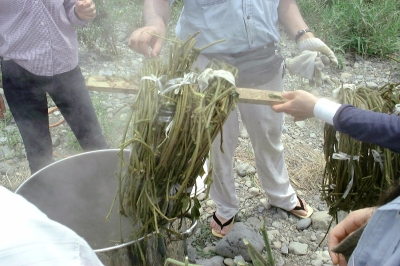
We boil the vine wreaths as soon as possible after harvest. If we cannot boil them soon, we put them in water to avoid they would be dried in sunlight. We boil the kudzuvine wreaths in a giant cauldron for around 20 minutes. They gradually smell like boiled green soybeans and show vivid green colour. They change their colour from green to yellow eventually, when is the best time to take them out from the cauldron. Then, we put them in water.
3. Fermentation
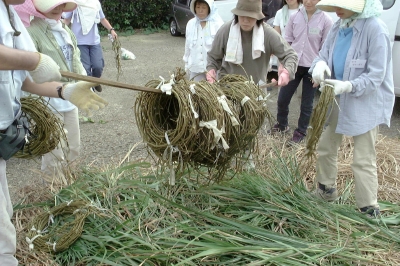
We cut silver grass leaves and lay them on the ground, then put kudzu vine wreaths on them. Silver grass leaves should cover the kudzu vine wreaths thoroughly. We put a straw mat over the silver grass leaves mound and weight it by placing some stones on the mound. After 4~5 days, we put our hands into the grass mound to know whether kudzu's outer skin becomes slimy. Then take the vine out from grasses.
4.Wash
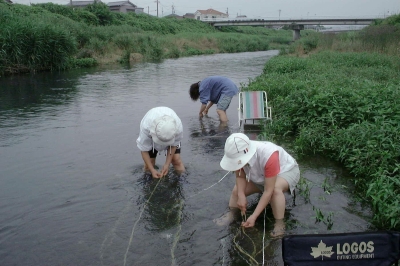
We wash the kudzu's outer skin off in a river.
5. Fukuronuki
We grab the bottom of a vine and remove its bast from its core,
then wash the bast thoroughly. Otherwise its quarity will be worse.
6. Dry
We dry these bast fibres straight on a shore of a river. These kudzu bast are called "Kudzuo".
7. Making tsuguri
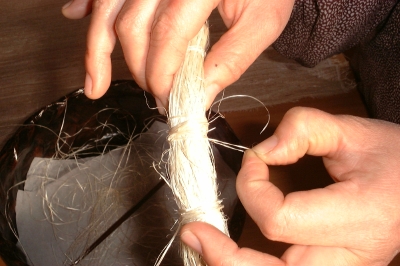
We split kudzu bast fibres 1-2mm in width and tie both of the two threads' edges with "Kudzu Knot". Put these tied theads into a basket. In this way, kudzu threads become longer. When the basket becomes full of threads, we put the upside basket down to take the threads out. Put a cup of rice bran on the threads mound, then make a figure 8 with the threads arond a chopstick. When it becomes the size of a young cucumber, stop making figure 8 and tie it at three places, then pull a chopstick out of the threads. We call it "Tsuguri".
8.weaving
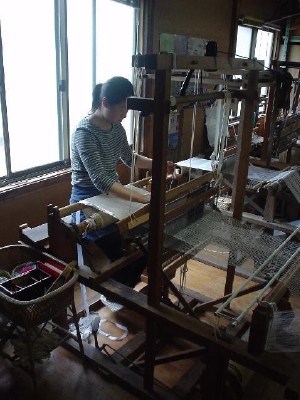
Almost all kudzufu are woven in plain weaving. Kudzu weaving is so delicate that it can be woven only by hands. The fluffs on its surface must be cut off by scissors. Then, beat the fabric with a wooden comb (we call that process "Kinutauchi") to add shine and softness.
Remarks
Kudzu's harvest time is from late May to early August. But I guess the best time is July in this region. However, depending on the climate of the year, the haevest season of kudzu is dfferent.
Silver grass leaves have many bacillus bacteria on its surface. And they can promote fermentation of kudzu. Bacillus bacteria are the most active at 37℃, almost same as human body temperature. Bacillus bacteria can decompose cellulose, so they can soften kudzu fiber. Bacillus bacteria never hurt kudzu's fibre. Therefore kudzu fibre can keep its beautiful shining.When the fermentation is in good condition, we find white mould on the kudzu vine's surface.
This white mould is a spore of bacillus bacteria, proving that the fermentation process has been completed.
The best way to get good fibre is to wash the vines in a river with pure water. Washing with tap water will entangle the fibres and loose its shining.
Drive a reed at a slant against the warp to avoid the kudzu threads would be crushed.
Those who work for Yaeyama jo-fu and Basho- fu make threads into cocoon-shaped for weft. In case of using cocoon-shaped, the weft tends to be twisted when it is pulled out from a shuttle. On the other hand, we make kudzu threads into cucumber-shaped tsuguri for the weft to protect them from being twisted.
Kudzufu loom's rear beam is usually higher than its front beam to avoid the kudzu threads being crushed. And the reed is lighter than the standard looms' one.

